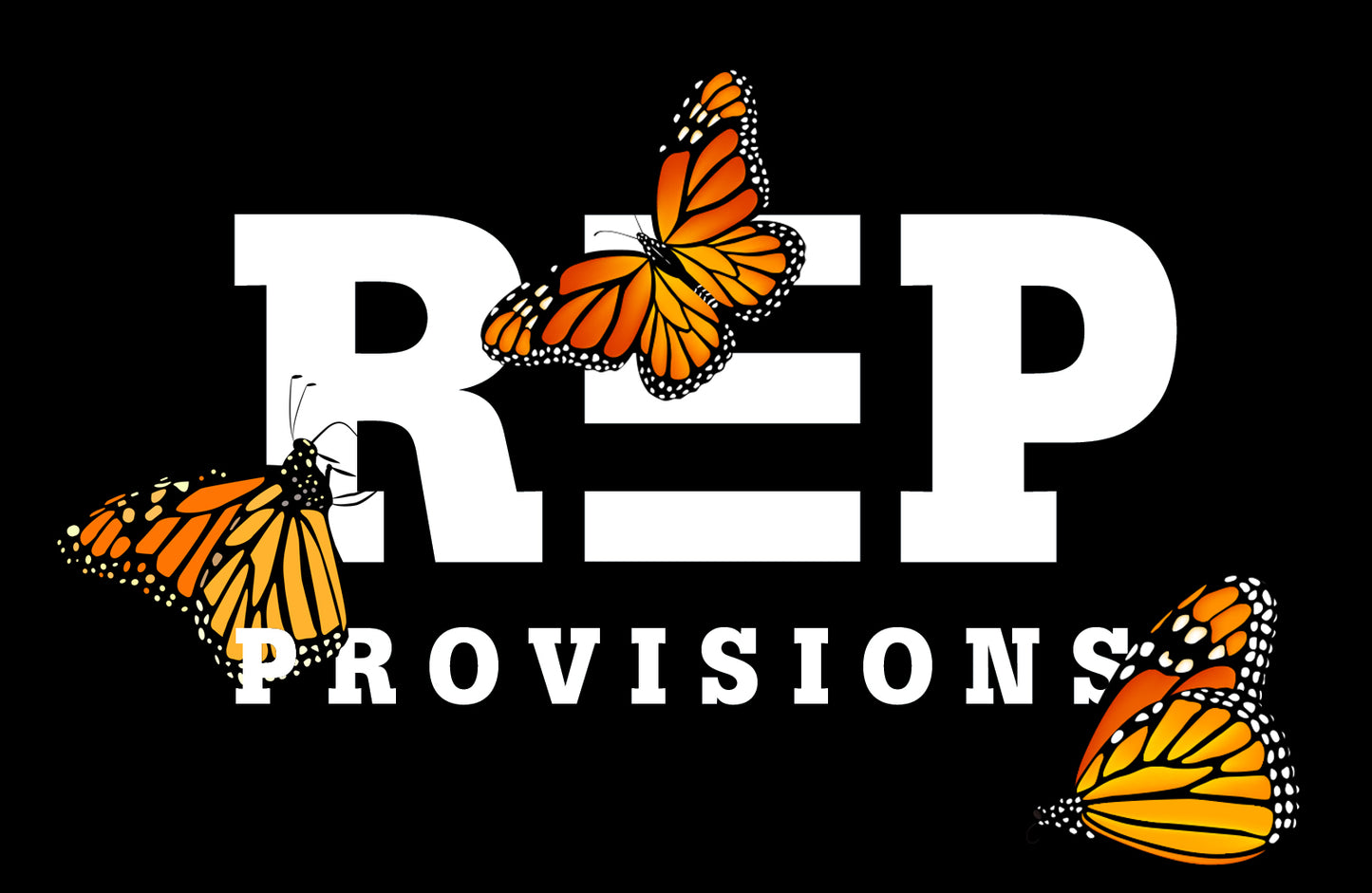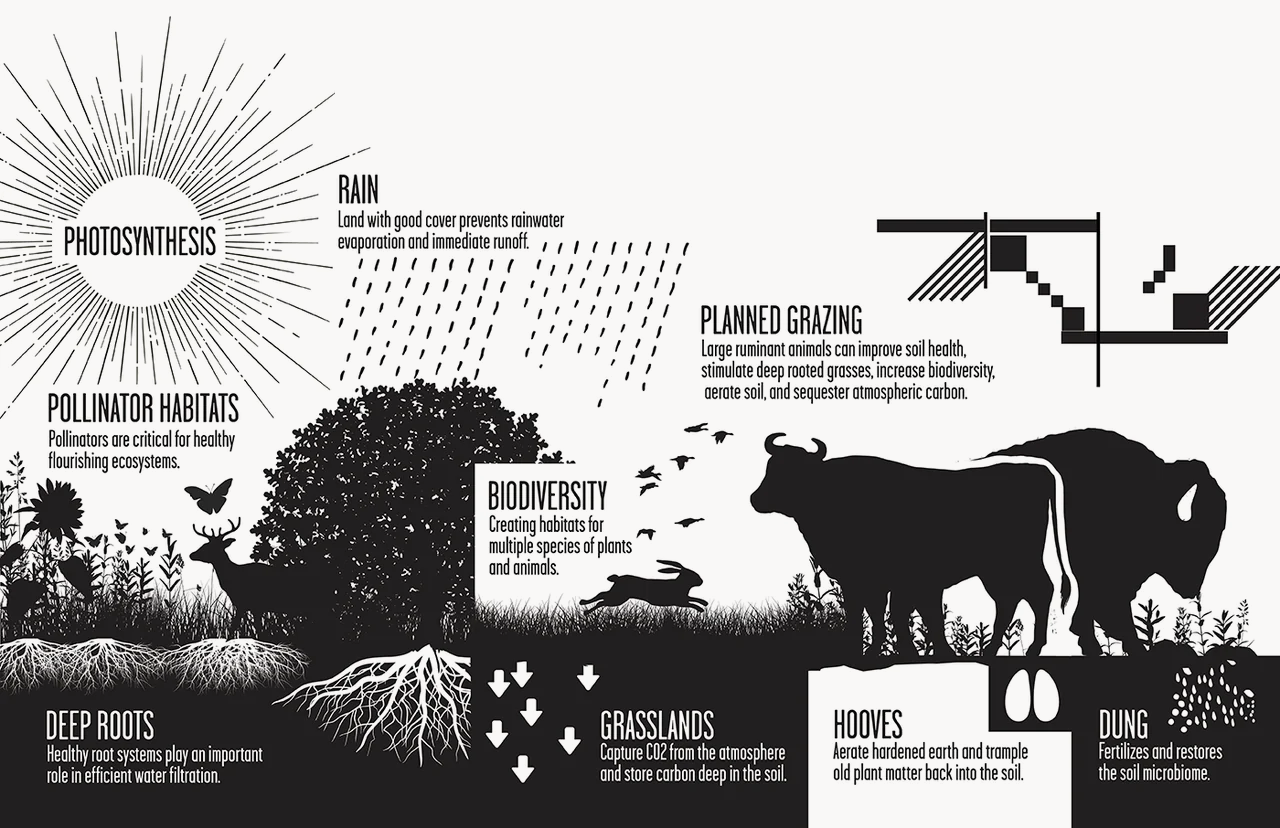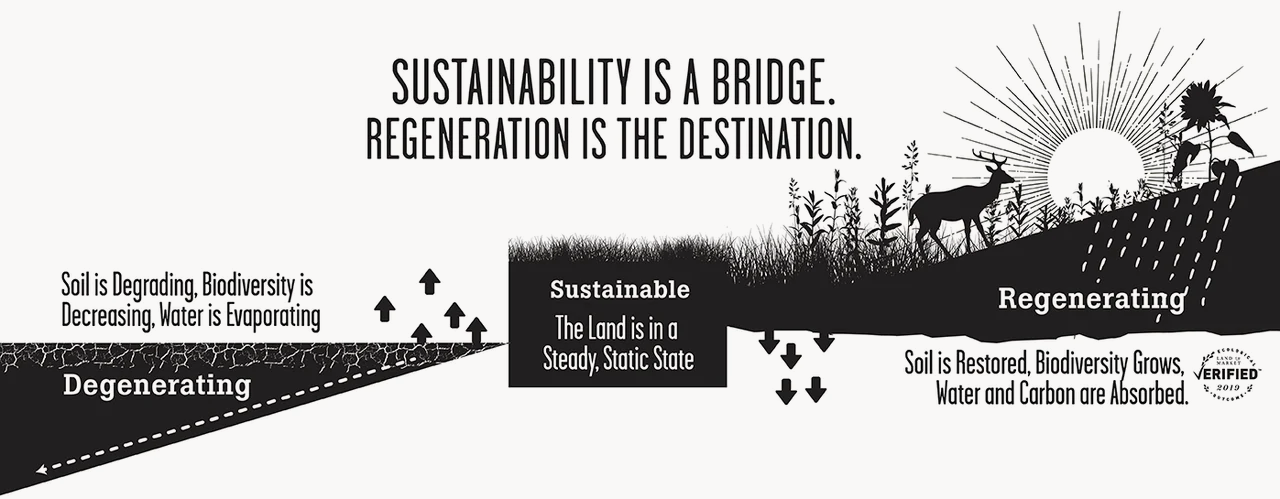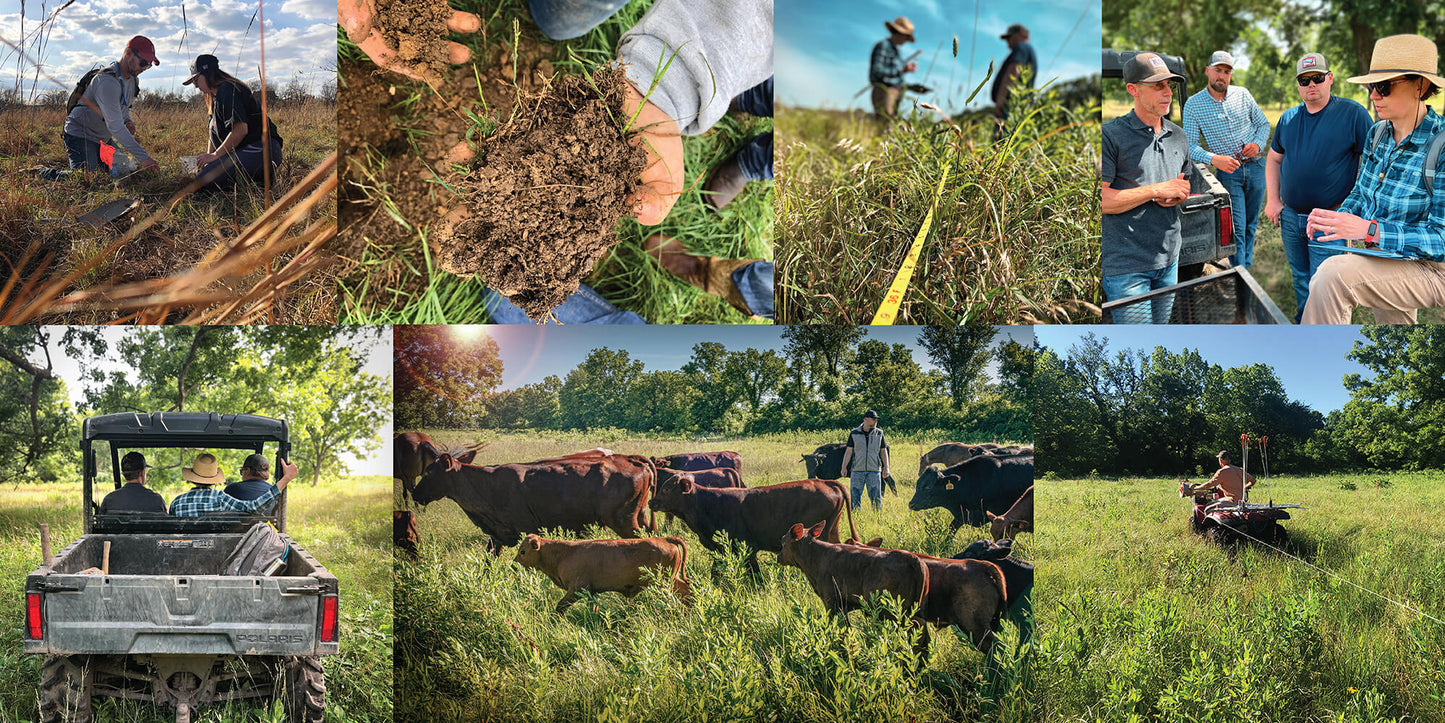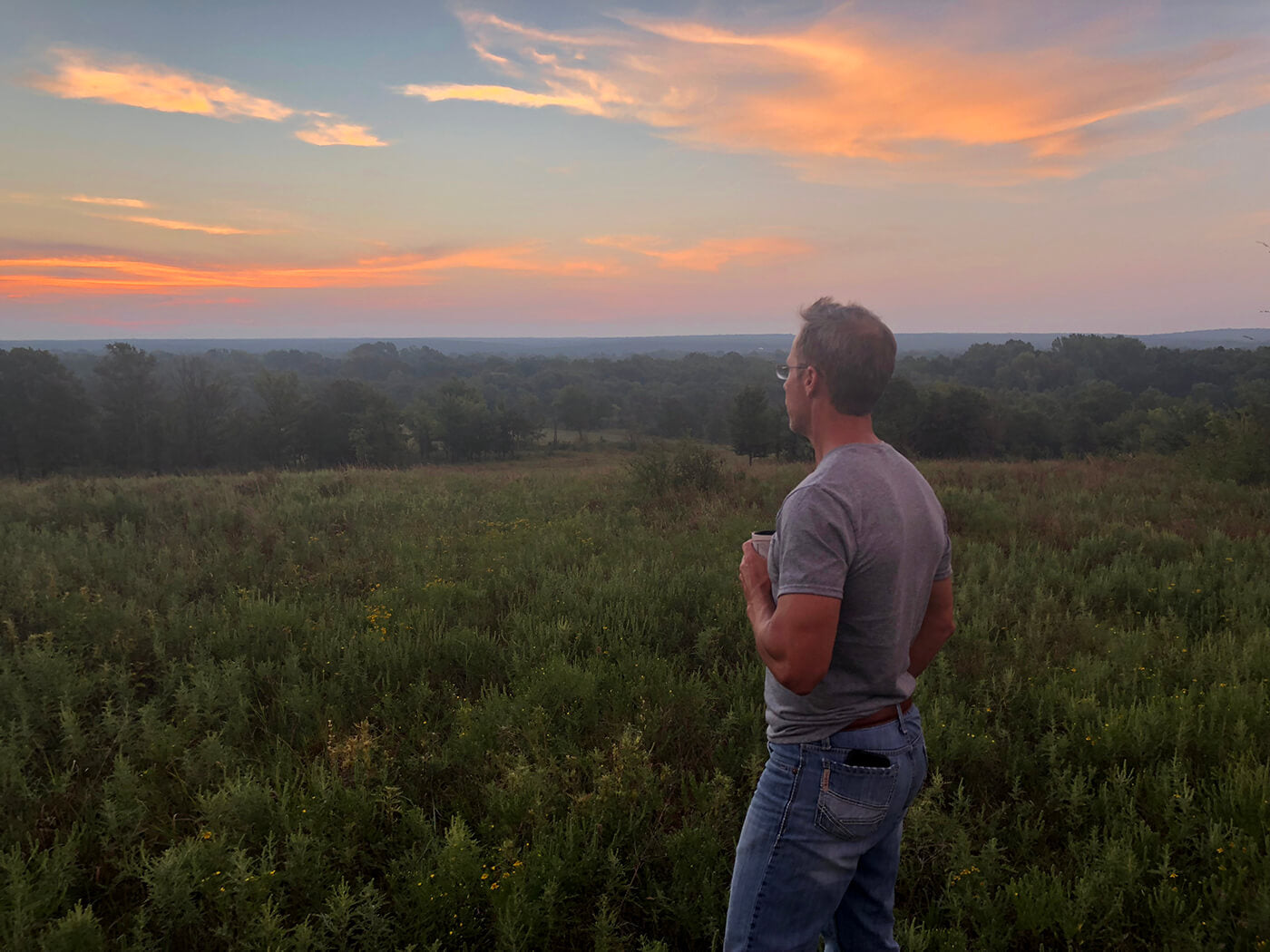Beyond Sustainable – What is Regenerative Agriculture?
To keep it simple, regenerative agriculture is a holistic land-management framework that heals our land through farming in harmony with nature. It’s a science and an artform that goes beyond sustainability, because it actively improves land health instead of leaving it the same or worse. As regenerative farmers and ranchers, we trust in this ancient framework to ensure a better future for us all.
Regenerative Agriculture: Holistic Land Management
- A philosophy, art, and science of farming in harmony with nature.
- Mimics nature’s design; every creature has a role to play.
- Responsibly grazing livestock enhances plant and animal biodiversity.
- Manure feeds soil – the foundation of all ecosystems.
- Healthy soil means no chemical fertilizers, herbicides, and pesticides.
- Healthy soil makes food more nutritious and delicious.
Regenerative Agriculture: Nutrition
- Regenerative foods contain greater concentrations of essential minerals, vitamins, and nutrients than conventionally farmed foods.
- Monocultures – and factory farming increase rates of nutrient deficiency.
- 100% Grass-finished beef raised on regenerative farms is significantly more heart healthy due to its perfectly balanced 1:1 omega-3:omega-6 fatty acid profile.
Regenerative Agriculture: Animal Welfare
- 100% pasture-raised – animals eat a natural diet.
- They live in the sunshine, forage, and breathe fresh air.
- Healthy environments breed healthy livestock.
- We never use antibiotics, hormones, mRNA vaccines, pesticides, or GMO’s; we don’t need to.
Regenerative Agriculture: Farmers and Ranchers
- By expanding production from one product to many –farmers generate higher incomes and greater job security.
- REP rewards farmers using regenerative methods by paying them far more than they could get in the conventional markets.
- Putting more money in farmers pockets is not only good for them but for the local economy in their rural communities.
Regenerative Agriculture: Systemic Solutions
- Built on decades of research and indigenous communities – regenerative agriculture empowers us to tackle some of humanity’s largest issues.
- Keeping soils covered builds resilience to flood and drought.
- Rotational grazing sucks carbon from the atmosphere into our soil.
- Grazing also mitigates the risk of invasive species and wildfires.
- No pesticides = better air + water quality.
Why Regenerative Matters.
Soil is where the health of our entire system begins. Regenerative agriculture feeds soil microbes, soil feeds plants, plants feed livestock, and this exchange continues up the food chain all the way to us humans.
It’s no coincidence that as our soils have been depleted, so have the amounts of vitamins, nutrients, and minerals in your food. In fact, the food that you’re eating today is far less nutritious than it was 50 years ago. While you may be consuming more calories, your body is starving for proper nutrition.
Beyond the health of your body, restoring our soils offers a proven solution to some of the greatest systemic issues facing humanity today. Healthy soils sequester carbon, impact the quality of our air and water, mitigate the effects of flooding and drought, as well as contribute to a more resilient food system in the face of climate change.
We don’t talk about it. We live it – everyday.
Verified Regenerative.
Conservation Ranching.
Monarch Waystation.
Reclaim your Birthright: Regeneratively Farmed Foods
The truth is that before conventional agriculture stole the show, regenerative farming was the norm. Together, we’re answering the call for a more nutritious and resilient food system; one that supports hard working American ranchers and farmers. The truth is - legacy food companies can’t back into this. Regenerative is built from the ground up.
What Does Regenerative Mean?
Regenerative Agriculture is a conservation and rehabilitation approach to farming and food production. To put it simply, it’s a way of raising animals that benefit nature and improve the land they live on. We believe that happy prairies are the key to healthy people and we are doing everything we can to make sure they stay that way.
Regenerative agriculture focuses on: topsoil regeneration, increasing biodiversity, carbon sequestration, improving water-cycles, and ecological restoration.
What is Regenerative Meat?
Regenerative meat is simply meat that was raised by farmers using holistic practices on land that is regenerating and becoming healthier over time. The term "regenerative meat" is more about how the animals were raised and how the land was managed than about the meat itself.
What are the Benefits of Regenerative?
Regenerative agriculture describes holistic farming systems that, among other benefits, improve water and air quality, enhance ecosystem biodiversity, produce nutrient-dense food, and store carbon to help mitigate the effects of climate change.
At REP we are also seeing that these changes create better tasting food with higher nutrient-densities. The product is more flavorful and it's better for you. Our beef was tested by Michigan State University and has some incredible benefits.
How are Regenerative Products Verified?
The Savory Institute is a 501(c)(3) non-profit, that audits and verifies our regenerative efforts. If our scientific datasets indicate that the land is regenerating and becoming healthier - we are able to claim the Land to Market Verification and implement their L2M Seal on our products.
Who is the Savory Institute?
Savory Institute is a 501(c)(3) non-profit based in Boulder, Colorado with 54 regional learning Hubs around the globe. Founded in 2009, the Institute has trained over 14,000 farmers, ranchers, and pastoralists and influenced management of over 17 Million hectares of grasslands through the adoption of Holistic Planned Grazing – a process that mimics ancestral grazing patterns of wild herbivores that co-evolved with healthy grassland ecosystems. Developed by Allan Savory in the 1960’s, Holistic Management (HM) has been proven in a wide variety of contexts to regenerate grasslands, build soil, increase biodiversity, and sequester significant amounts of carbon while also improving social and economic outcomes.
What does the Land-to-Market Seal Mean?
A leader in the regenerative agriculture movement, Land to Market is the world's first outcomes-based verified regenerative sourcing solution.
The program's Land to Market Verified seal has attracted some of the world's leading consumer packaged goods companies, apparel brands and retailers.
A program of the Savory Institute, Land to Market uses a science-based approach working directly with raw material producers to enhance transparency and traceability mechanisms across the entire value chain.
What is Ecological Outcome Verification (EOV)?
Ecological Outcome Verification (EOV) is the science inside the Savory Institutes Land to Market Program. It was developed in collaboration with leading soil scientists, ecologists, agronomists, and an extensive network of regenerative land managers around the world. EOV is a practical and scalable soil and landscape assessment methodology that tracks outcomes in biodiversity, soil health, and ecosystem function (water cycle, mineral cycle, energy flow and community dynamics).
EOV MEASURES REGENERATION THROUGH A HOST OF ECOLOGICAL INDICATORS: GROUND COVER, WATER INFILTRATION, BIODIVERSITY, SOIL CARBON AND SOIL HEALTH.
EOV™ was developed by Savory Institute in collaboration with Michigan State University, Texas A&M, Ovis 21, The Nature Conservancy, and an extensive network of regenerative land managers around the world.
How Does Regenerative Meat Reverse Climate Change?
Through photosynthesis healthy grassland ecosystems remove carbon from the atmosphere and store in the soil (where it belongs!). In order to maximise the carbon sequestering capacity of these thriving grasslands the symbiotic presence of grazing animals is required. As a result when managed in nature’s image cattle, bison and other ruminant animals have the ability to enrich a system that reverses climate change.
What is Grass-fed, Grass-finished & Pasture-Raised?
Grass-finished comes from animals that ate nothing but grass and forage for their entire lives. Grass-fed, on the other hand, may be used to label meat from animals that were started on a grass diet but have either received supplemental grain feed or are finished on a fully grain-based diet. Grass-fed does not mean that the animal spent any time in a pasture, they could have been fed hay in a feedlot. 100% Grass-fed is the same as grass-finished and pasture-raised.
